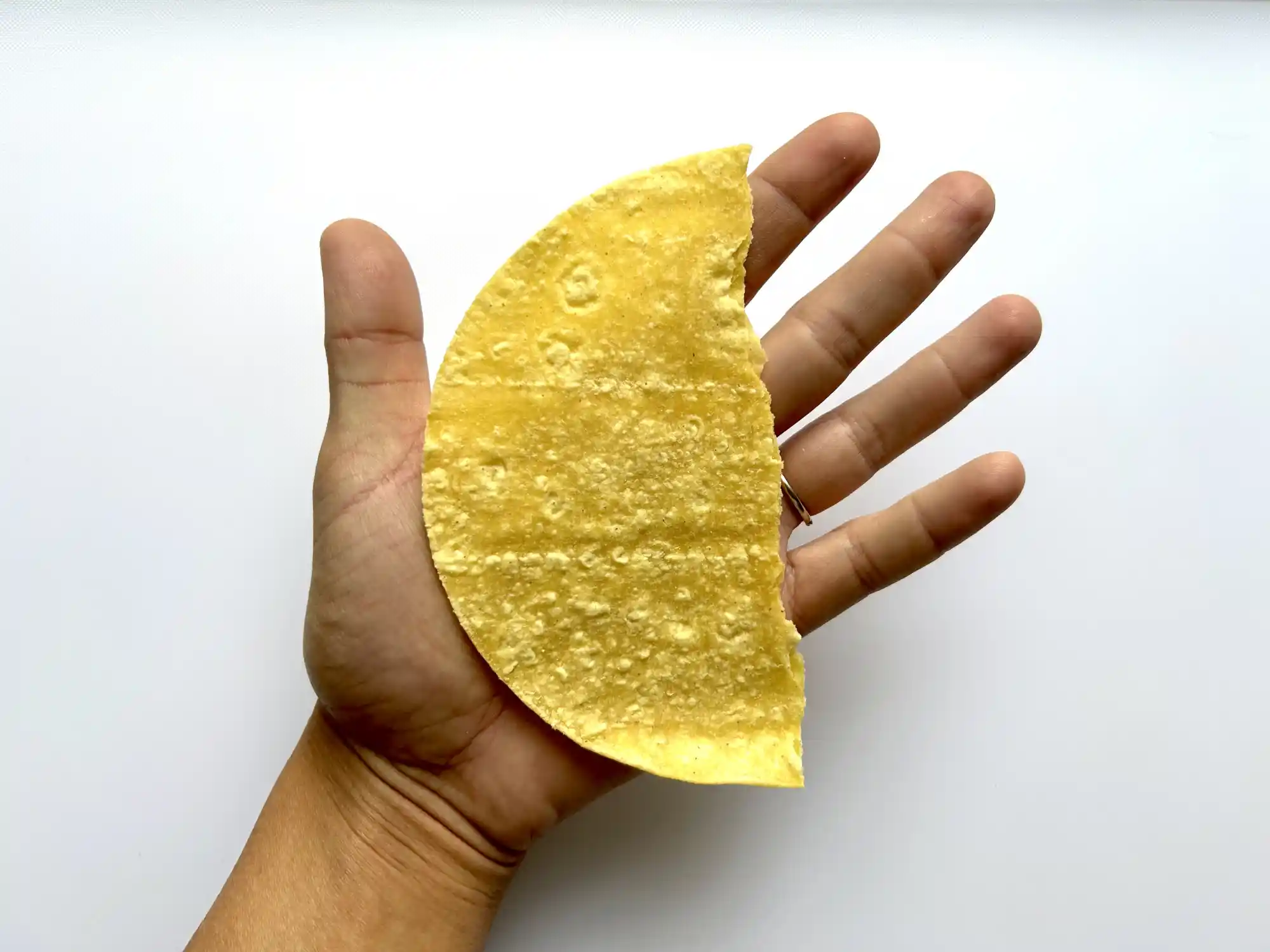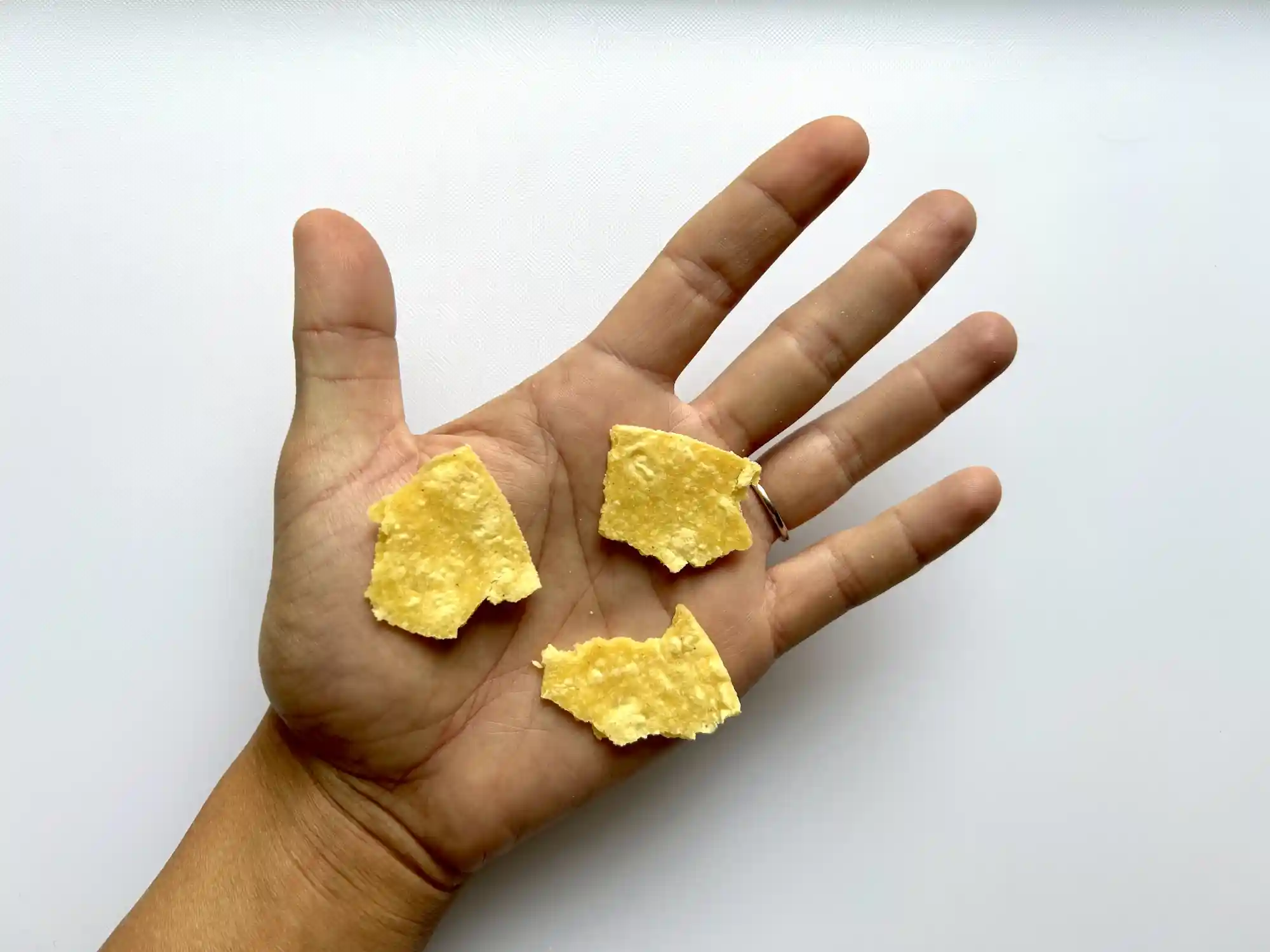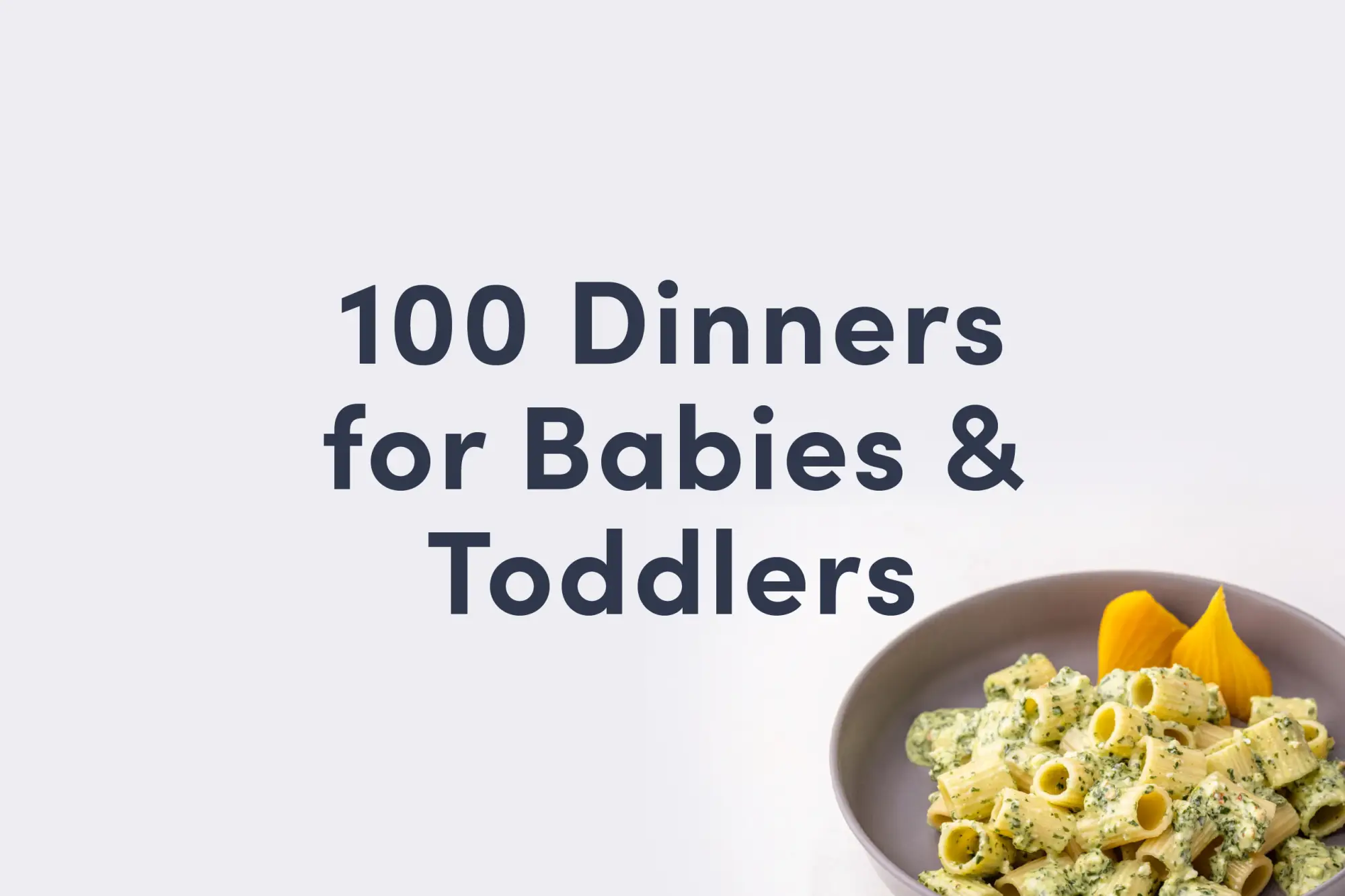Tortilla
Grain
Age Suggestion
6 months
Iron-Rich
No
Common Allergen
Yes

When can babies have tortillas?
Soft corn tortillas may be introduced as soon as baby is ready to start solids, which is generally around 6 months of age. Consider holding off on wheat tortillas until after a baby’s first birthday, as they tend to get gummy and difficult to manage in the mouth.
Food historian Maricel Presilla has called tortilla “an ancient bread that is enormously complex”—a fair description. Tortilla is a staple food in the Americas, where the name applies to an unleavened flatbread traditionally made of corn, a sacred food. Tortilla is also known as chaw, gueta, hme, tlaxcalli, and waaj to people living in Mexico and Central America, whose ancestors learned how to turn corn into nourishing bread in ancient times. Spanish colonizers saw a resemblance between that flatbread and a simple “little cake” made of wheat and cooked over cinders in their homeland. They called the Indigenous bread by the same name, “tortilla,” and demanded it be made with wheat—still the grain preferred by some today.
Are tortillas healthy for babies?
Yes. Tortillas are generally rich in carbohydrates to provide energy for growth, crawling, and exploration. Depending on the type, they can also offer fiber to support baby’s gut microbiome.
Aside from these similarities, tortillas made with different ingredients and methods will have different nutritional benefits. Tortillas made with nixtamalized corn have resistant starch to feed friendly bacteria in the gut. Blue corn tortillas contain extra antioxidants, particularly the anthocyanins that give the tortilla its blue hue. Wheat tortillas (which are often enriched) can offer a good amount of zinc and various B-vitamins. That said, regulations differ from country to country on the enrichment of grains with added nutrients, so the nutritional content of tortillas can vary depending on their country of origin.
Are tortillas a common allergen?
It depends. While many tortillas are commonly made from corn, many others are made from wheat or a blend of wheat and corn, and wheat is a common allergen. Gluten-free or grain-free tortilla varieties may also contain additional top allergens including milk, soy, and tree nuts. If your child has a food allergy, be sure to read the label on tortillas thoroughly.
Wheat is one of the most common food allergens in children. Fortunately, two-thirds of children outgrow the allergy by their 12th birthday. Individuals with Oral Allergy Syndrome (also known as pollen food allergy syndrome) may be sensitive to wheat, particularly those who are allergic to birch and grass pollen. While rare, some individuals have a condition known as wheat-dependent, exercise-induced anaphylaxis, which can result in a severe allergic reaction if the person exercises within a few hours after eating wheat. These patients should avoid eating wheat in the four hours before strenuous activity.
It is important to note that wheat allergy is not the same as celiac disease. While a wheat allergy may be outgrown, celiac disease requires a strict, lifelong gluten-free diet and lifestyle. A gluten “allergy” is typically a misnomer, often in reference to celiac disease.
Corn tortillas are made from corn, which is not a common allergen, although reactions to corn are not unheard of. However, corn and corn products have been identified as a trigger of food protein-induced enterocolitis syndrome, also known as FPIES. FPIES is a rare and delayed allergy to food protein which causes the sudden onset of repetitive vomiting and diarrhea to begin a few hours after ingestion of the food trigger. Left untreated, the reaction can result in significant dehydration. Fortunately, most cases resolve completely during childhood. To learn more about FPIES, read our post on Food Allergens and Babies. Individuals with Oral Allergy Syndrome (also known as pollen food allergy syndrome) may be sensitive to corn, particularly those who are allergic to grass or plane pollen. Oral Allergy Syndrome typically results in short-lived itching, burning, or tingling in the mouth, but abdominal pain has also been reported with some cereal grains. It is unlikely to result in a dangerous reaction.
If you suspect your baby is allergic to wheat, talk to a pediatric health care provider before introducing wheat tortillas at home. As you would when introducing any new food, start by offering a small quantity for the first few servings and watch closely for any signs of an allergic reaction. If there is no adverse reaction, gradually increase the amount over future servings.
Are tortillas a choking hazard for babies?
No. Soft tortillas present a low risk when safely prepared for a child’s age and developmental ability, though, in theory, an individual could choke on any food. Keep in mind that crispy or crunchy tortillas and tortilla chips are choking hazards and best reserved for older children with mature eating skills. To reduce the risk, prepare and serve tortillas in an age-appropriate way. As always, make sure you create a safe eating environment and stay within an arm’s reach of baby during meals.
Learn the signs of choking and gagging and more about choking first aid in our free guides, Infant Rescue and Toddler Rescue.
Videos
When can kids have tortilla chips?
If a child has developed mature eating skills (taking small bites with their teeth, moving food to the side of the mouth when chewing, chewing thoroughly before swallowing, not stuffing food in their mouth, and spitting out food when it is not well chewed) they may be ready to learn how to eat whole tortilla chips (as well as other crunchy chips and crackers). For some children, this could be as young as 18 months, but others closer to age 2 or 3. When you see these signs of readiness, start by modeling. Explain to the child: "I am going to eat this chip. It's a tough one, and I need to crunch it up with my strong side teeth." Take a small bite and exaggerate chewing it. Bring attention to the crunching sounds and show your child how it is chewed up before you swallow it. Then give the child a small piece to practice with (big enough that they can hold it and bite a piece off).
Tortilla chips are considered a choking hazard until 4 years of age. Although we have not been able to identify any data to support this, we assume it is due to the sharp edges of the tortilla chip and the fact that they are slightly more challenging to chew than other foods. Swallowing part of an unchewed tortilla chip can certainly be uncomfortable, but is most likely not harmful for the pharynx and esophagus. It is also not a high risk for choking (blocking the airway), as it is not small, round, or slippery.
That said, a child being mobile and unsupervised while eating significantly increases choking risk with all foods, and tortilla chips are a common snack item at parties, where children are often on the move. It can be easy for a toddler to grab a chip from a bowl without being noticed by a caregiver. This is why it is important to practice eating chips and crackers with children when they are seated and supervised.
Can I serve grain free tortillas to babies and toddlers?
Yes. Grain-free tortillas can be made with flours including almond, cassava (yuca), cauliflower, chia seed, chickpea, coconut, flaxseed (linseed), or quinoa. Depending on the main ingredients, these grain-free tortillas can be quite gummy and sticky or very crumbly, so depending on the consistency, they may be more appropriate for children older than 12 months of age. Keep in mind that the nutritional benefits will also vary depending on what ingredients are used to make the tortilla. Some may contain common allergens as well, so read labels carefully if food allergies are a concern.
How do you serve tortillas to babies?
Every baby develops on their own timeline, and the suggestions on how to cut or prepare particular foods are generalizations for a broad audience.
6 months old +:
Offer baby a soft corn tortilla cut in half or into long strips about the size of two adult fingers held together. When the tortilla is fresh and soft, serve it on its own, passing the piece in the air for baby to grab from you and munch on. If it is more dry and brittle, try steaming or soaking the tortilla in broth to soften it for baby. Either way, the chewy texture of a tortilla likely means that baby won’t consume much, however, holding and munching can help build baby’s chewing skills. Alternatively, mix shredded tortilla into soft, scoopable foods, such as bean chili or huevos rancheros. The softer texture is easier for baby to consume. Wheat or flour tortillas can get gummy in the mouth and difficult for babies to manage, but if you’d like to serve them, try toasting or lightly frying in a pan to make the tortilla less gummy. Hold off on serving crunchy tortillas and tortilla chips, which are sharp and challenging to chew.
9 months old +:
At this age, babies develop their pincer grasp (where the thumb and forefinger meet), which enables them to pick up smaller pieces of food. When you see signs of this development, try moving down in size to bite-sized pieces of soft corn tortilla. Serve the pieces on their own for baby to practice picking up or mix them into other foods. This is also a great age to serve tortilla with a broth, salsa, or stew and offer some pieces plain, some pieces that have been dipped in the food. Wheat or flour tortillas can get gummy in the mouth and difficult for babies to manage, but if you’d like to serve them, try briefly warming the tortilla in a pan to make it more resistive and less gummy. Hold off on serving crunchy tortillas and tortilla chips, which are sharp and challenging to chew.
12 months old +:
As a toddler advances their chewing and spitting skills, wheat or flour tortillas can be introduced. Try using soft corn, wheat (white or whole grain), or grain-free tortillas to make enchiladas, quesadillas, huevo encamisado and other dishes. If you’d like, you can try serving tacos made with soft tortillas. You can cut the tacos in half to make them a more manageable size, but know that, at this age, many toddlers will take the taco apart and eat the components separately, and that is completely fine.


¿Busca guías en español? Check out our guides available in Spanish.
Written by
Expert Tips Delivered to Your Inbox
Sign up for weekly tips, recipes and more!
The content offered on SolidStarts.com is for informational purposes only. Solidstarts is not engaged in rendering professional advice, whether medical or otherwise, to individual users or their children or families. No content on this site, regardless of date, should ever be used as a substitute for direct medical advice from your doctor or your medical or health professional, nutritionist, or expert in pediatric feeding and eating. By accessing the content on SolidStarts.com, you acknowledge and agree that you are accepting the responsibility for your child’s health and well-being. In return for providing you with an array of content “baby-led weaning” information, you waive any claims that you or your child may have as a result of utilizing the content on SolidStarts.com.








